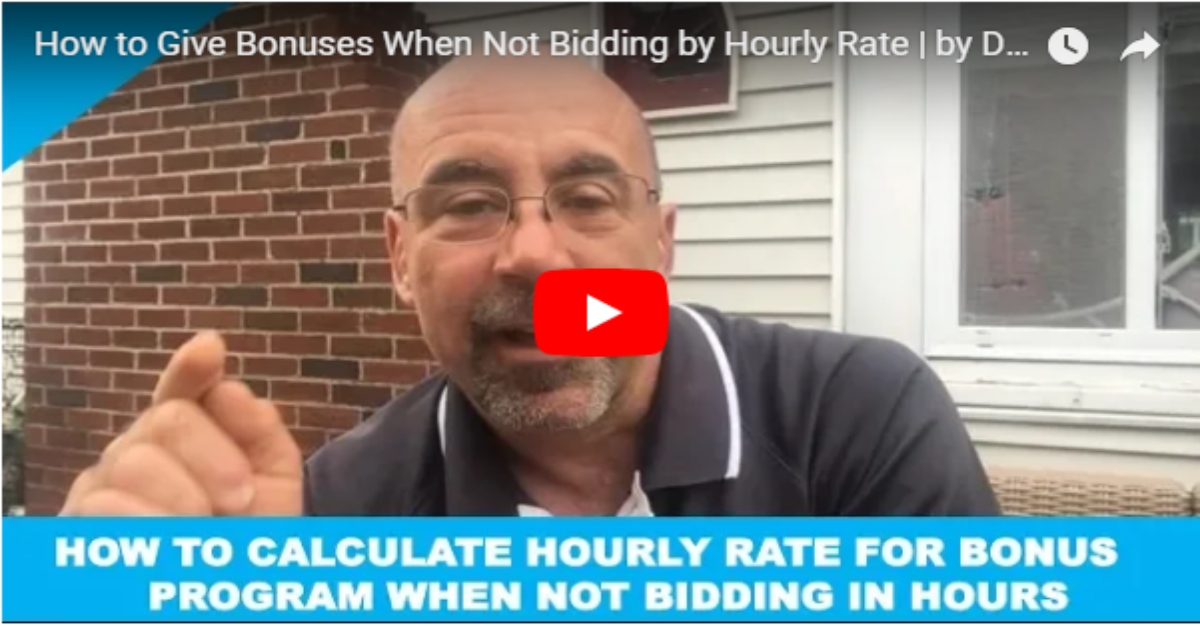
How to Give Bonuses When Not Bidding by Hourly Rate
Hello everybody; Employee bonuses, and a question that just through yesterday regarding this.
I am Ron Ramsden and I am a DYB coach, also a painting contractor.
The reason I tell you I am a painting contractor is I love those big wins and those big jobs but I also feel the pain sometimes when things don’t go right.
Today we want to talk about employee bonuses, we talked about this in our previous video, which we will link the video to this one.
But, the question is, what happens on our employee bonus structure when it is based on hours, if you don’t bid hours?
Such as, if you look at the side of a house, or look at a room and just say, it is going to be $400 to paint, it is going to be $2000 to paint.
Or maybe in your mind, you know what it is, but you don’t actually have it broken down to your hourly rate.
Download Your FREE Checklist...
11 Interview Questions For Hiring All-Stars, E-mailed to you NOW!

So, we’re going to use rounded numbers because they are easy to calculate.
If your bid rate is at $50 an hour –some of you may be less, some of you may be much higher, it all depends on many factors we can’t get to in this video –but if it is a $50 an hour bid rate, that’s your labor rate and that does not include materials.
And you are doing a project, maybe you looked at a house or looked at a room and say, it is going to be $1000 to paint it, plus material.
Or you didn’t break it down, you didn’t really use production rates or anything like that, you just kind of did a wild guess or a guesstimate on what it was going to be.
But in your mind, you have probably done this so many times, it is probably pretty accurate.
So, let’s break this down, how many hours is this going to be, because we know if we told one crew member, go paint that room, it’s going to take them two (2) days, and another crew member, it is going to take them seven (7) hours.
So, we want to supply the crew member the number of hours it is going to take to actually accomplish a task, they don’t know if they are doing great with their numbers.
They might think they are killing it, maybe they are doing over-prep on these jobs, and maybe you have to let them know like you have 20 hours to complete this job.
They have to factor in their head, the prep, the setup, the clean-up, the painting, and making sure the customer is happy, loading the van –the whole bit goes into those hours of production.
Let’s go back to your $50 an hour.
So, we looked at a job, it is going to be $1000 labor, maybe say $150 for the material. The whole job is now $1,150.
So, how many hours is this going to take?
Well, if your bid rate is correct and it is going to be $1000 for labor, we are going to take the $1000, and divide it by your hourly rate which is $50, which give us 20 hours to complete this task.
Is it right on? We don’t know until it is actually done.
At the end of a couple of these jobs, you can actually look at your overall bidding process to find out bidding that way, does that work?
We do have a couple of those jobs that happen now and then that there is actually no bid price.
It is sometimes a guesstimate or it’s a conversation between me and a homeowner at a time and things aren’t measured right, but we still have to provide our crews with a number of hours for each job so they can earn their bonuses, they have something to strive for.
And also because they are not working too many hours on that job.
So anyway, I hope this helped? If you like more information about the Employee Bonus Program, please send me a message, it is ron@dybcoach.com.
Or you can reach out to me on Facebook, I would love to chat with you, we can either have a conversation on Facebook or we can exchange cell phone numbers, I would love to chat. Bye…
